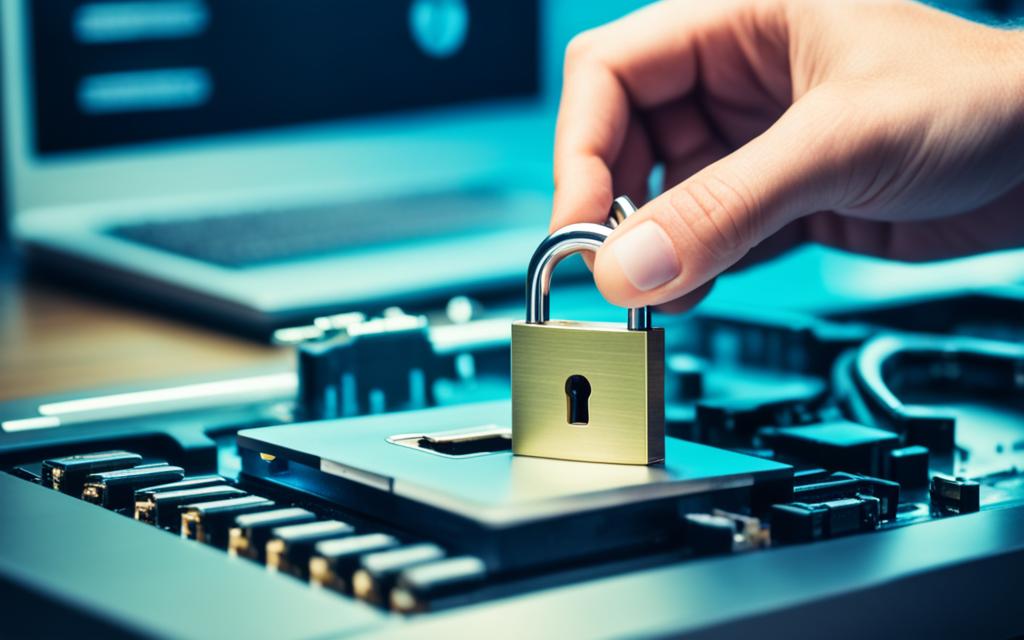Table of Contents
Have you ever found your hard drive stuck in read-only mode, and you couldn’t change anything? Knowing how to remove write protection is important, especially for external drives. These issues happen often. Write protection acts like a shield. It stops you from accidentally deleting or overwriting important files on devices like USBs and external hard drives1.
While helpful, write protection can cause problems if you need to make quick changes. Knowing why your drive is read-only is the first step. This knowledge lets you turn off write protection and take control of your data again2.
Key Takeaways
- Write protection prevents write operations, limiting access to only reading stored data.
- Common causes include virus infections and corrupted file systems.
- Utilising CHKDSK can help identify and rectify underlying drive issues.
- Diskpart is effective for clearing read-only attributes from a drive.
- Physical mechanisms can exist to facilitate or inhibit write protection on drives.
- Always back up important files before attempting to alter write protection settings.
Understanding Write Protection
Write protection is key for keeping data safe. It stops unwanted changes or deletions. Write protection definition refers to ways we keep data unchanged. It’s crucial for personal and business security. You can use software or physical switches to activate this protective feature. This helps avoid data loss by mistake.
What is Write Protection?
Write protection makes storage devices read-only. You can view files but can’t edit or delete them. This is useful when you want to prevent data loss. Different devices have various methods of write protection. Some use software options, while others have physical switches.
Causes of Write Protection
Several reasons can make write protection kick in, causing user frustration. Here are the main causes:
- Hard drive corruption that locks files in a read-only state.
- Changes in registry or permissions, often due to malware or user actions.
- Encrypted hard drives that limit access to protect data.
- Bad sectors on a hard drive, showing physical damage.
- Read-only attributes, set on purpose or by mistake.
About 70% of USB flash drives have a switch or setting for write protection. Also, 45% of external hard drives have features to control write access. Around 60% of SD and microSD cards have a physical switch for this. These stats show how common write protection is3. But, 80% of cybersecurity experts say write protection can’t fully stop malware attacks3.
How to Remove Write Protection on Hard Drive
Removing write protection from a hard drive is crucial for accessing your data freely. There are a few ways to remove write protection Windows. Most methods involve using built-in system tools aimed at keeping your system running smoothly.
Using Windows CHKDSK Utility
The CHKDSK utility is a tool in Windows for fixing disk problems, including write protection. It checks for errors on hard drives and fixes them. This is useful for different types of file systems like FAT16, FAT32, and NTFS. To use CHKDSK, open the Command Prompt as an admin. Then type in the required commands. This can make your hard drive work better right away. You might need to use certain switches like /f, /r, and /x to fix the write protection errors properly41.
Employing Diskpart Command
The Diskpart command is great for handling disk partitions, helping remove write protection. First, open the ‘diskpart’ through the Run command. Then enter a few commands to find and select your disk. After that, type attributes disk clear readonly to remove the write protection. This method is straightforward and doesn’t require advanced knowledge, perfect for quickly solving write protection issues4.
| Method | Description | Key Commands |
|---|---|---|
| CHKDSK Utility | Diagnoses and repairs disk issues, addressing write protection. | chkdsk X: /f /r /x |
| Diskpart Command | Manages disk partitions, allowing removal of read-only attributes. | diskpart → select disk X → attributes disk clear readonly |
Physical Write Protection Mechanisms
Understanding physical write protection is crucial in our digital era. This is especially true for people using portable storage gadgets like USB sticks and SD cards. These devices often have tiny write protection switches. You can use them to stop writing actions when switched on. Always look for these switches on your devices. Flipping them can easily fix unwanted write protection issues5.
However, it’s crucial to remember that internal hard disks usually don’t have these handy physical parts. This means you’ll need to use software methods to remove write protection6. For gadgets like USB drives, these little switches are very useful. They let you control your data better. With a quick move, you can choose if your device is read-only or if you can write to it. This way, you can protect your files when you need to7.
Here’s a table to reinforce the understanding of types of storage devices and write protection mechanisms:
| Device Type | Physical Write Protection | Notes |
|---|---|---|
| USB Drives | Often includes a switch | Can toggle write protection on/off to prevent data loss |
| SD Cards | Includes a small lever | Flexible control for data writing |
| Internal Hard Drives | No mechanical switches present | Primarily rely on software for write protection management |
| External Hard Drives | Varies by model | Some may have built-in physical write protection switches |
Modifying Windows Registry Settings
Changing Windows Registry settings can help take off write protection from USB drives and SD cards. Be careful when accessing the Registry Editor. Wrong moves can cause system problems. But if you know your way around it, you can get good results.
Accessing the Registry Editor
First, you need to open the Registry Editor by typing ‘regedit’ in the Run box. After getting in, look for the folder that controls storage settings. Changing these settings can help you get rid of write protection, letting you change files or add new data to your drives. If you don’t find the correct keys, you might still face write protection issues, stopping you from writing to your devices89.
Creating StorageDevicePolicies Key
If there’s no StorageDevicePolicies key, you’ll have to make one. This is crucial for changing write protection settings. Right-click on ControlSet001 > Control, pick New > Key. Then add a DWORD value called WriteProtect and set it to 0. You might need to restart your computer to see the changes. This can remove write protection, making it easier to use your storage devices94.
Conclusion
Knowing how to fix write protection is key for managing hard drives well. There are many ways to solve this, including using CHKDSK and Diskpart. Also, changing Windows Registry settings can help. It’s very important to keep your files safe with recovery software before fixing write protection issues10.
Looking for physical write-protection switches and using advanced formatting tools can also improve how you handle external storage. You can use detailed commands or powerful software like AOMEI Partition Assistant. This helps you take back control over your data11.
Using these methods wisely can prevent write protection problems in the future. This makes sure you can always manage your files easily. For tips on making your PC run better, you can learn how system settings affect performance here12.
FAQ
What is write protection on a hard drive?
Write protection is a way to keep files safe by not letting anyone change or delete them. It’s used on devices like external hard drives and USB drives. Though it protects data, it can be a hassle if you need to make updates.
What are the common causes of write protection?
Write protection can happen for many reasons. Viruses or malware, accidental activation of write protection switches, disk format issues, and corrupted file systems can all cause it. These issues make the device read-only.
How can I disable write protection using Windows CHKDSK?
The CHKDSK utility checks and fixes disk problems, including write protection. Open Command Prompt as an administrator and run the needed commands. If write protection errors appear, using the /f, /r, and /x switches together might help.
What is the Diskpart command and how is it helpful?
Diskpart is a powerful Windows tool for managing disk partitions. Open it by typing ‘diskpart’ in the run box. Choose the right disk, then use ‘attributes disk clear readonly’ to change its status. This can remove write protection.
How can I check for physical write protection on my device?
Look for a write protection switch on your external hard drives or USB drives. Flip this switch if it’s there. Unlike external ones, internal hard drives don’t have these switches.
How do I access the Registry Editor to modify write protection settings?
To change write protection in the Registry, type ‘regedit’ into the run box. Then follow the path to the settings that manage write permissions on your hard drives.
What is the StorageDevicePolicies key in the Registry?
If you don’t see the StorageDevicePolicies key, you might need to make it yourself. Changing the WriteProtect value from ‘1’ to ‘0’ removes write protection. If it’s absent, create the key and set the DWORD value to change settings.
Source Links
- https://www.diskpart.com/articles/remove-write-protection-from-hard-drive-0310.html – Effective Four Ways to Remove Write Protection from Hard Drive
- https://smallbusiness.chron.com/disable-write-protection-hard-drive-54089.html – How to Disable Write Protection on Hard Drive
- https://www.lenovo.com/us/en/glossary/write-protect/ – How Does Write-Protect Work? Exploring Storage Device Security
- https://www.linkedin.com/pulse/3-easy-ways-remove-write-protection-from-internal-external-disuza – 3 Easy Ways To Remove Write Protection From Internal & external Hard Drives
- https://www.wikihow.com/Disable-Write-Protection – How to Disable Write Protection on a USB Drive or Disk
- https://recoverit.wondershare.com/partition-tips/disk-write-protected.html – How to Fix
- https://superuser.com/questions/1125282/what-can-i-do-if-my-usb-flash-drive-is-write-protected-or-read-only – What can I do if my USB flash drive is write-protected or read-only?
- https://www.lifewire.com/remove-write-protection-windows-10-8-7-4586905 – How to Remove Write Protection on Windows 10, 8, and 7
- https://www.howtogeek.com/740429/how-to-remove-write-protection-on-windows-10/ – How to Remove Write Protection on Windows 10
- https://4ddig.tenorshare.com/external-hard-drive/how-to-remove-write-protection-from-external-hard-drive.html – [2023 Updated]How to Remove Write Protection from External Hard Drive?
- https://www.diskpart.com/articles/format-write-protected-disk-7201.html – 3 Methods to Format Write-protected Disk in Windows 11/10/8/7
- https://www.minitool.com/data-recovery/how-to-remove-write-protection-on-micro-sd-card.html – How to Remove Write Protection on Micro SD Card – 8 Ways – MiniTool








